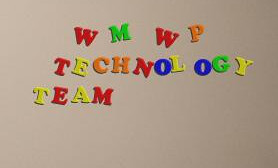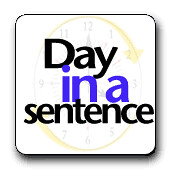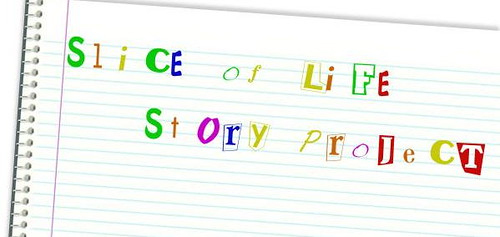This week, we returned to the traditional format of Day in a Sentence and again, my comment box overflowed with your words. Some were celebratory. Some were full of sadness. All of them were heartfelt and I thank you for being part of this reflective community. This month, I have been part of the Comment Challenge and it occurs to me that our Day in the Sentence project (now a few years old) is one way that we are using blogs and comments to connect with each other.
In the spirit of the Comment Challenge, which seeks to encourage more thoughtful interaction among bloggers, might I suggest that you follow the links to one of the other writers here and post a comment on their blog? It would be a nice way for us to connect outside of the Day in a Sentence community.
Here, then, are your sentences:
Jo had the great pleasure of watching learning happening naturally as her students took charge with words and worked together.
“At my desk cutting out stacks of freshly laminated writing-prompt pictures (printed for free as a site’s treat for Teacher Appreciation week), I had to force myself not to stare agape, not to gush, as my tenth-graders helped each other discover through snaps and claps and finger pointing the actual ease of blank verse (”no, listen, ’success’ is two syllables: ’suck’ ‘cess’”); those moments of realization, of lights being switched on (or even perhaps undimmed a bit), are some of the sweetest morsels at the teaching table.“
Elona had a difficult week in which her doctor’s orders took a wrong turn. Luckily, it was only temporary, and we are glad that she is back to feeling better.
“Oh my goodness, I’m glad the week is almost over because I had a bad reaction to some medication I was taking and ended up in bed for a couple of days, although thankfully I’m fine now.  “
“
Anne M. is reminded, and reminds us, that although our circles of bloggers may be immersed in the realm of Web 2.0, there are more teachers in the world who are not aware of it than teachers who are.
“Reflections on 10 months of my personal and classroom use of web2.0 tools, enabled me to put together a presentation for our regional teachers, on “where I would start with web2.0″ at a local conference, instigating an awareness that many teachers had not even heard of web2.0, including podcasting. So, where do we start?“
Cynthia (she is probably not alone) was happy to have Day in a Sentence back in its traditional format. In a note to me, she calls herself the “prodigal child” who is returning. Hey, Cynthia! You never left! But it is great to have your voice here again, and you’re given some freedom to extend your sentence as long as you need it to be.
“Friday I got up at 5:30, saw Larry off to work, Adair and her family to Dallas, before going to school where we worked on our Oral Interp mask poem presentations; then it was off to Baccalaureate practice for an hour and back to school for English II–but not before two students brought me limeades from Sonic; thank goodness I was really thirsty–finished Julius Caesar, took up Macbeth projects, said goodbye to the seniors, played Murder Mystery with the eighth graders, after which it was on to the Catholic Church for a wedding rehearsal and to Natchez for the rehearsal supper; finally, around 9:30 I was home again just in time to fall into the bed so I could wake up and start all over again.“
I have had the great pleasure of conversing with Diane in the Comment Challenge and I was so happy to see her submit a sentence as part of this week’s Day in a Sentence. She is a bit cryptic in her sentence, which is very cool.
“Putting the puzzle pieces together – the picture underneath starts to emerge.“
The prospect of the weekend was looking awfully nice for Delaine. I hope it was fun and rejuvenating, because Monday is staring right down at us.
“As we get closer to the summit, the climb gets harder, and I am thankful for the restcamp of the weekend.“
Alice seems to have some conflicts going on and determined that bringing things out in the open is always the best way to deal. Keep quiet and the tension and frustration only grows. Bring it out into the open and maybe something gets resolved.
“Although this week had it’s ups and downs, it was an improvement over last week, as the conflicts were in the open, and not festering in our minds and souls.“
Nina decided against her own sentence and instead, found a great sentence from one of her favorite authors, John McPhee, who writes in the book Uncommon Carriers: “He became the editor-in-chief of Screw Machine Engineering, a magazine whose name a hyphen would have improved.” (p. 25)
She then asks us: “How could I do better than that?” Well, why even try? That sentence carries the day, in my opinion.
Bonnie found light this week and a reminder of the passion that some teachers have for their students, even when their own life interferes.
“I enjoyed visiting a middle school this week, watching my student teacher work with a very pregnant, passionate teacher who is only leaving because her doctor demanded it, and this is a district with it diversity challenges. Makes you feel optimistic.”
The number referenced here by Cheryl just boggled my mind, as her district moves on with standardized testing. We do the same next week (it’s Math Time, baby).
“This week was week one for our NWEA online testing. We uploaded over 1200 completed tests this week. One day of glitches, problem solved finally! We still have 2 weeks to go. Students take this seriously and try and do a great job.“
Larry could use a field trip to recover from the field trip. If he does plan one, can we come along? Hey, I drove down that crooked street once, many years ago. But a video game museum? Interesting. Do you have a link?
“Another insane field trip with 100 students to San Francisco — submarine tour, chocolate factory, video game museum, the crookedest street in the world (among other things) — and a day (or two) to recover.“
Stacey, who has helped guide some of my writing with her own Slice of Life and Poetry challenges, noted that, on the day she submitted her words, the day had barely begun. I hope it got better and not worse.
“My great-aunt, the matriarch of our family, is ill and I’m not quite sure what’s going to happen next.“
Spring fever hits Sara P. hard. Does that mean summer is around the bend? Uh Oh. Lots to do and not much time to do it.
“I call firsties – first to point out how quickly the end of the school year is approaching (just 21 days for me!), first to admit early summer-ish weather shouldn’t be followed by late winter-ish weather (55 degrees and torrential rain – are you kidding me?!), and first to notice i no longer need to hassle my kids about wearing hoodies and hats into class (though i’ve just switched to the new line “no, if you don’t put leggings under your mini-skirt, you *can’t* wear it.”) – Ah, May!“
Ben B. writes about another way in which he is not afraid to stand by his beliefs.
“Bloom’s Taxonomy, although convenient, has lately faced pretty strong scrutiny in my world and yet I still stand by it.“
Google, Google, Google for Janelle, as she sets off on a Big Explore.
“The downpour of rain is not the only thing that pounds down on my head as I mull over mounds of TELPAS files and experiment with Google Apps & Google Sites—forecast is clear for the weekend!“
Matt mourned an emotional loss of someone close and dear to him, and I believe I speak for everyone when I say that our thoughts are with you, Matt (who wrote a powerful eulogy at his blog this week).
“After 97 years and a couple of appearances in my previous sentences, my grandmother died this week. My heart is heavy but I know that I have learned from her and am a better person for having had her as a part of my life.”
Liza, like Cheryl and myself, is in the storm of testing, and it is clear she does not like the feeling.
“Recovering from state mandated testing leaves me feeling unfocused and at loose ends.“
And Sue, who is one of the organizers of the Comment Challenge and a wonderful resource for all bloggers, had her battles this week with Technorati as she tried to make sure bloggers in the challenge were connected via their tags. She found hurdles, but not dead roadblocks. And no doubt her optimism kept her going. (yeah for Sue!)
“Technorati mocked me, drove me crazy but I defeated it for now.“
Please visit each other and tell them that Kevin sent ya on a mission. Leave a comment. Say hello. Make a connection.
And it is not too late to leave your own sentence either. Just use the comment link on this post and your words will be added in. You are invited!
Peace (in our community),
Kevin





